Assessing the Potential Highest Storm Tide Hazard in Taiwan Based on 40-Year Historical Typhoon Surge Hindcasting
Abstract
1. Introduction
2. Data and Models
2.1. Historical Typhoon Events
2.2. Tide-Measuring Stations
2.3. Surge-Wave Coupled Model
2.4. Model Setup
2.5. Hybrid Typhoon Wind Model
3. Results
3.1. Characteristics of the Highest Astronomical Tides
3.2. Importance of Waves to Storm Surge
3.3. Distribution of the Highest Storm Surge
3.4. Assessment of Potential Highest Storm Tide Hazard
4. Discussion
5. Conclusions and Summary
Author Contributions
Funding
Acknowledgments
Conflicts of Interest
References
- Neumann, B.; Vafeidis, A.T.; Zimmermann, J.; Nicholls, R.J. Future coastal population growth and exposure to sea-rise and coastal flooding—A global assessment. PLoS ONE 2015, 10, e0131375. [Google Scholar] [CrossRef] [PubMed]
- Smith, L. Environmental Hazards: Assessment Risk and Reducing Disaster, 2nd ed.; Routledge: London, UK, 1996. [Google Scholar]
- Nicholls, R.J.; Wong, P.P.; Burkett, V.R.; Codignotto, J.O.; Hay, J.E.; McLean, R.F.; Ragoonaden, S.; Woodroffe, C.D. Coastal Systems and Low-Lying Areas. Climate Change 2007: Impacts, Adaptation and Vulnerability; Contribution of Working Group II to the Fourth Assessment Report of the Intergovernmental Panel on Climate, Change; Parry, M.L., Canziani, O.F., Palutikof, J.P., van der Linden, P.J., Hanson, C.E., Eds.; Cambridge University Press: Cambridge, UK, 2007; pp. 315–356. [Google Scholar]
- Lee, H.S.; Kim, K.O. Storm surge and storm waves modelling due to Typhoon Haiyan in November 2013 with improved dynamic meteorological conditions. Procedia Eng. 2015, 116, 699–706. [Google Scholar] [CrossRef]
- Dasallas, L.; Lee, S. Topographical Analysis of the 2013 Typhoon Haiyan Storm Surge Flooding by Combining the JMA Storm Surge Model and the FLO-2D Flood Inundation Model. Water 2019, 11, 144. [Google Scholar] [CrossRef]
- Mori, N.; Kato, M.; Kim, S.; Mase, H.; Shibutani, Y.; Takemi, T.; Tsuboki, K.; Yasuda, T. Local amplification of storm surge by Super Typhoon Haiyan in Leyte Gulf. Geophys. Res. Lett. 2014, 41, 5106–5113. [Google Scholar] [CrossRef] [PubMed]
- Qi, J.H.; Chen, C.S.; Beardsley, R.C. An unstructured-grid finite-volume surface wave model (FVCOMSWAVE): Implementation, validations and applications. Ocean Model. 2009, 28, 153–166. [Google Scholar] [CrossRef]
- Roland, A.; Zhang, Y.J.; Wang, H.V.; Meng, Y.; Teng, Y.-C.; Maderich, V.; Brovchenko, I.; Dutour-Sikiric, M.; Zanke, U. A fully coupled 3D wave-current interaction model on unstructured grids. J. Geophys. Res. 2012, 117, C00J33. [Google Scholar] [CrossRef]
- Dietrich, J.C.; Zijlema, M.; Westerink, J.J.; Holthuijsen, L.H.; Dawson, C.N.; Luettich, R.A., Jr.; Jensen, R.E.; Smith, J.M.; Stelling, G.S.; Stone, G.W. Modeling hurricane waves and storm surge using integrally-coupled, scalable computations. Coast. Eng. 2011, 58, 45–65. [Google Scholar] [CrossRef]
- Krien, Y.; Dudon, B.; Roger, J.; Zahibo, N. Probabilistic hurricane-induced storm surge hazard assessment in Guadeloupe, Lesser Antilles. Nat. Hazards Earth Syst. Sci. 2015, 15, 1711–1720. [Google Scholar] [CrossRef]
- Krien, Y.; Dudon, B.; Roger, J.; Arnaud, G.; Zahibo, N.P. Assessing storm surge hazard and impact of sea level rise in the Lesser Antilles case study of Martinique. Nat. Hazards Earth Syst. Sci. 2017, 17, 1559–1571. [Google Scholar] [CrossRef]
- Chen, W.-B.; Chen, H.; Chang, C.-H.; Hsiao, S.-C.; Su, W.-R.; Yu, Y.-C.; Chen, Y.-M.; Lin, L.-Y. Quantifying the Contribution of Nonlinear Interactions to Storm Tide Simulations during a Super Typhoon Event. Ocean Eng. 2019. Submitted. [Google Scholar]
- Yang, M.; Chen, K.-H. A new height reference network in Taiwan. Surv. Rev. 2003, 37, 260–268. [Google Scholar] [CrossRef]
- Luettich, R.A.; Westerink, J.J.; Scheffner, N.W. ADCIRC: An Advanced Three-Dimensional Circulation Model for Shelves Coasts and Estuaries, Report 1: Theory and Methodology of ADCIRC-2DDI and ADCIRC-3DL; Dredging Research Program Technical Report DRP-92-6; U.S. Army Engineers Waterways Experiment Station: Vicksburg, MS, USA, 1992; 137p. [Google Scholar]
- Westerink, J.J.; Luettich, R.A.; Muccino, J.C. Modelling tides in the western north Atlantic using unstructured graded grids. Tellus 1994, 46, 178–199. [Google Scholar] [CrossRef]
- Bunya, S.; Dietrich, J.C.; Westerink, J.J.; Ebersole, B.A.; Smith, J.M.; Atkinson, J.H.; Jensen, R.; Resio, D.T.; Luettich, R.A.; Dawson, C.; et al. A high-resolution coupled riverine flow, tide, wind, wind wave, and storm surge model for southern Louisiana and Mississippi. Part I: Model development and validation. Mon. Weather Rev. 2010, 138, 345–377. [Google Scholar] [CrossRef]
- Dietrich, J.C.; Bunya, S.; Westerink, J.J.; Ebersole, B.A.; Smith, J.M.; Atkinson, J.H.; Jensen, R.; Resio, D.T.; Luettich, R.A.; Dawson, C.; et al. A high-resolution coupled riverine flow, tide, wind, wind wave, and storm surge model for southern Louisiana and Mississippi. Part II: Synoptic description and analysis of Hurricanes Katrina and Rita. Mon. Weather Rev. 2010, 138, 378–404. [Google Scholar] [CrossRef]
- Westerink, J.J.; Luettich, R.A.; Feyen, J.C.; Atkinson, J.H.; Dawson, C.; Roberts, H.J. A basin to channel scale unstructured grid hurricane storm surge model applied to southern Louisiana. Mon. Weather Rev. 2008, 136, 833–864. [Google Scholar] [CrossRef]
- Tanaka, S.; Bunya, S.; Westerink, J.J.; Dawson, C.; Luettich, R.A. Scalability of an Unstructured Grid Continuous Galerkin Based Hurricane Storm Surge Model. J. Sci. Comput. 2010, 46, 329–358. [Google Scholar] [CrossRef]
- Kerr, P.C.; Donahue, A.S.; Westerink, J.J.; Luettich, R.A.; Zheng, L.Y.; Weisberg, R.H.; Huang, Y.; Wang, H.V.; Teng, Y.; Forrest, D.R.; et al. U.S. IOOS coastal and ocean modeling testbed: Inter-model evaluation of tides, waves, and hurricane surge in the Gulf of Mexico. J. Geophys. Res. Oceans 2013, 118, 5129–5172. [Google Scholar] [CrossRef]
- Smith, J.; Sherlock, A.; Resio, D. STWAVE: Steady-State Spectral Wave Model. User’s Manual for STWAVE, Version 3.0; Coastal and Hydraulics Laboratory, Engineer Research and Development Center, US Army Corps of Engineers: Washington, DC, USA, 2001. [Google Scholar]
- Booij, N.; Ris, R.C.; Holthuijsen, L.H. A third-generation wave model for coastal regions, Part I, model description and validation. J. Geophys. Res. 1999, 104, 7649–7666. [Google Scholar] [CrossRef]
- Tolman, H.L. User Manual and System Documentation of WAVEWATCH III. Technical Note 166; NOAA/NWS/NCEP/OMB: Washington, DC, USA, 1999. [Google Scholar]
- Garratt, J.R. Review of drag coefficients over oceans and continents. Mon. Weather Rev. 1977, 105, 915–929. [Google Scholar] [CrossRef]
- Komen, G.J.; Cavaleri, L.; Donelan, M.; Hasselmann, K.; Hasselmann, S.; Janssen, P.A. Dynamics and Modelling of Ocean Waves; Cambridge University Press: Cambridge, UK, 1994; 532p. [Google Scholar]
- Zijlema, M. Computation of wind–wave spectra in coastal waters with SWAN on unstructured grids. Coast. Eng. 2010, 57, 267–277. [Google Scholar] [CrossRef]
- Ris, R.C.; Holthuijsen, L.H.; Booij, N. A third-generation wave model for coastal regions: 2. Verification. J. Geophys. Res. Oceans 1999, 104, 7649–7666. [Google Scholar] [CrossRef]
- Xie, D.; Zou, Q.-P.; Mognone, A.; MacRae, J.D. Coastal flooding from wave overtopping and sea level rise adaptation in the northeastern USA. Coast. Eng. 2019, 150, 39–58. [Google Scholar] [CrossRef]
- Zou, Q.P.; Xie, D.M. Tide-surge and wave interaction in the Gulf of Maine during an extratropical storm. Ocean Dyn. 2016, 66, 1715–1732. [Google Scholar] [CrossRef]
- Hasselmann, K.; Barnett, T.P.; Bouws, E.; Carlson, H.; Cartwright, D.E.; Enke, K.; Ewing, J.A.; Gienapp, H.; Hasselmann, D.E.; Kruseman, P.; et al. Measurements of Wind-Wave Growth and Swell Decay during the Joint North Sea Wave Project (JONSWAP); Deutsches Hydrographisches Institut: Hamburg, Germany, 1973. [Google Scholar]
- Hasselmann, S.; Hasselmann, K.; Allender, J.H.; Barnett, T.P. Computations and parameterizations of the non-linear energy transfer in a gravity-wave spectrum, Part 2: Parameterizations of the non-linear energy transfer for application in wave models. J. Phys. Oceanogr. 1985, 15, 1378–1391. [Google Scholar] [CrossRef]
- Shao, W.; Sheng, Y.; Li, H.; Shi, J.; Ji, Q.; Tan, W.; Zuo, J. Analysis of Wave Distribution Simulated by WAVEWATCH-III Model in Typhoons Passing Beibu Gulf, China. Atmosphere 2018, 9, 265. [Google Scholar] [CrossRef]
- Blain, C.A.; Westerink, J.J.; Luettich, R.A. The influence of domain size on the response characteristics of a hurricane storm surge model. J. Geophys. Res. Oceans 1994, 99, 18467–18479. [Google Scholar] [CrossRef]
- Westerink, J.J.; Blain, C.A.; Luettich, R.A.; Scheffner, N.W. ADCIRC: An Advanced Three-Dimensional Circulation Model for Shelves Coasts and Estuaries, Report 2: User’s Manual for ADCIRC-2DDI; Dredging Research Program Technical Report DRP-92-6; U.S. Army Engineers Waterways Experiment Station: Vicksburg, MS, USA, 1994; 156p. [Google Scholar]
- Hagen, S.; Westerink, J.; Kolar, R.; Horstmann, O. Two-dimensional, unstructured mesh generation for tidal models. Int. J. Numer. Methods Fluids 2001, 35, 669–686. [Google Scholar] [CrossRef]
- Pan, Y.; Chen, Y.P.; Li, J.X.; Ding, X.L. Improvement of wind field hindcasts for tropical cyclones. Water Sci. Eng. 2016, 9, 58–66. [Google Scholar] [CrossRef]
- Chang, C.-H.; Shih, H.-J.; Chen, W.-B.; Su, W.-R.; Lin, L.-W.; Yu, Y.-C.; Jang, J.-H. Hazard Assessment of Typhoon-Driven Storm Waves in the Nearshore Waters of Taiwan. Water 2018, 10, 926. [Google Scholar] [CrossRef]
- Phadke, A.C.; Martino, C.D.; Cheung, K.F.; Houston, S.H. Modeling of tropical cyclone winds and waves for emergency management. Ocean Eng. 2003, 30, 553–578. [Google Scholar] [CrossRef]
- Jourdain, N.C.; Barnier, B.; Ferry, N.; Vialard, J.; Menkes, C.E.; Lengaigne, M.; Parent, L. Tropical cyclones in two atmospheric (re) analyses and their response in two oceanic reanalyses. Ocean Model. 2014, 73, 108–122. [Google Scholar] [CrossRef]
- Shao, Z.; Liang, B.; Li, H.; Wu, G.; Wu, Z. Blended wind fields for wave modeling of tropical cyclones in the South China Sea and East China Sea. Appl. Ocean Res. 2018, 71, 20–33. [Google Scholar] [CrossRef]
- Peng, D.; Hill, E.M.; Meltzner, A.J.; Switzer, A.D. Tide Gauge Records Show That the 18.61-Year Nodal Tidal Cycle Can Change High Water Levels by up to 30 cm. J. Geophys. Res. Oceans 2019, 124, 736–749. [Google Scholar] [CrossRef]
- Chen, W.-B.; Lin, L.-Y.; Jang, J.H.; Chang, C.-H. Simulation of Typhoon-Induced Storm Tides and Wind Waves for the Northeastern Coast of Taiwan Using a Tide–Surge–Wave Coupled Model. Water 2017, 9, 549. [Google Scholar] [CrossRef]
- Resio, D.T.; Westerink, J.J. Modeling the physics of storm surges. Phys. Today 2008, 61, 33–38. [Google Scholar] [CrossRef]
- Shih, H.-J.; Chen, H.; Liang, T.-Y.; Fu, H.-S.; Chang, C.-H.; Chen, W.B.; Su, W.-R.; Lin, Y.-Y. Generating potential risk maps for typhoon-induced waves along the coast of Taiwan. Ocean Eng. 2018, 163, 1–14. [Google Scholar] [CrossRef]
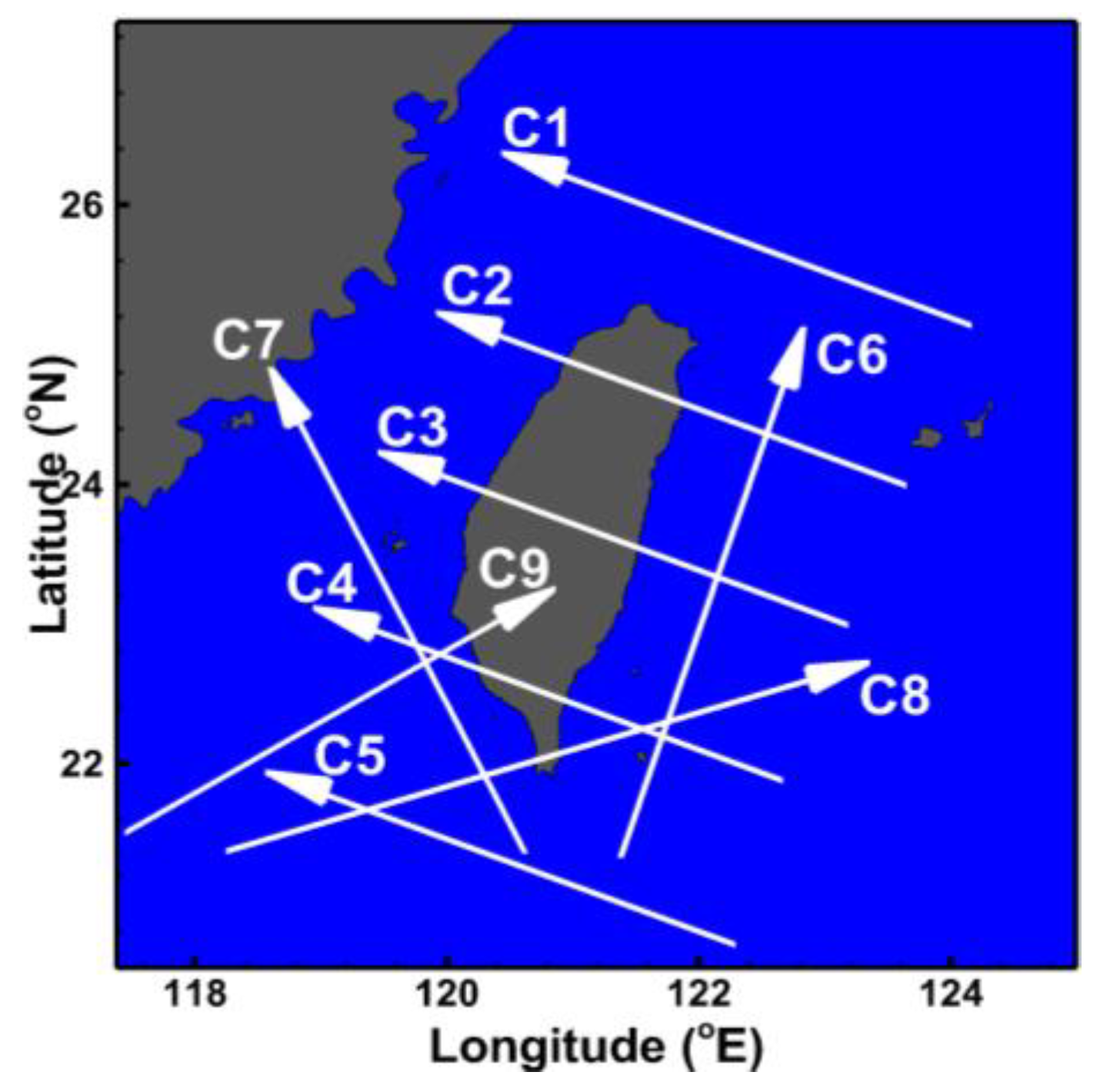
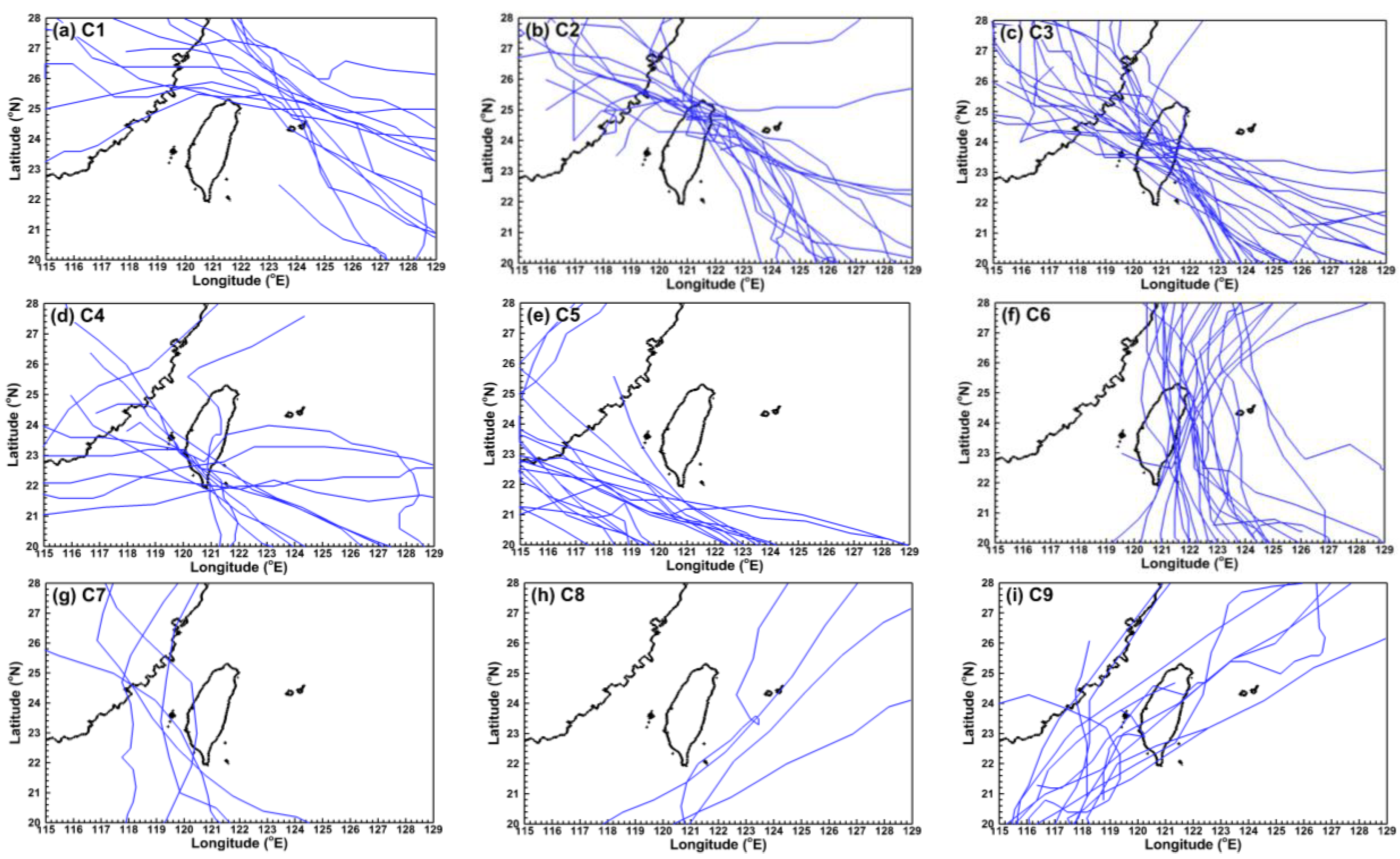
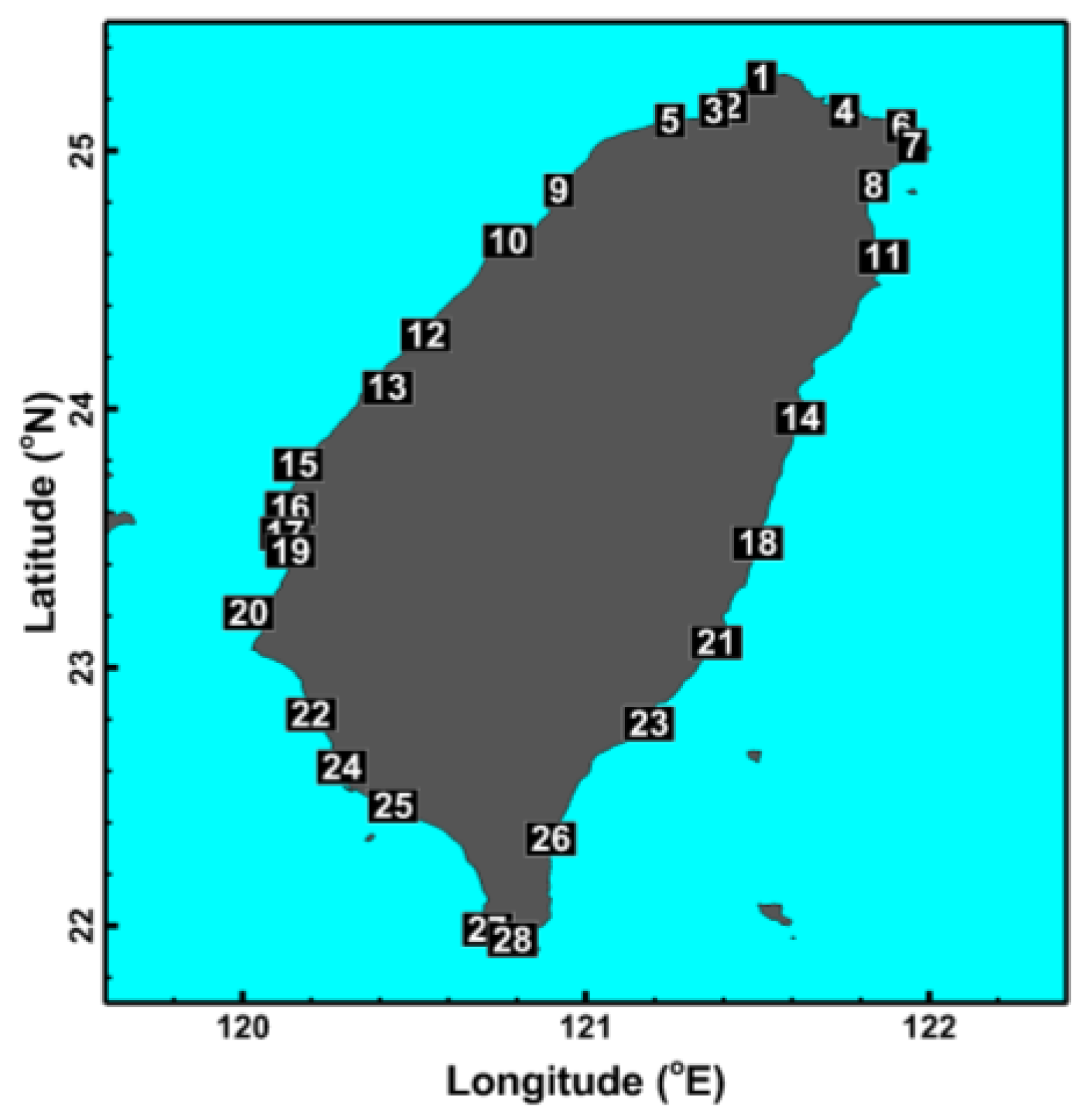
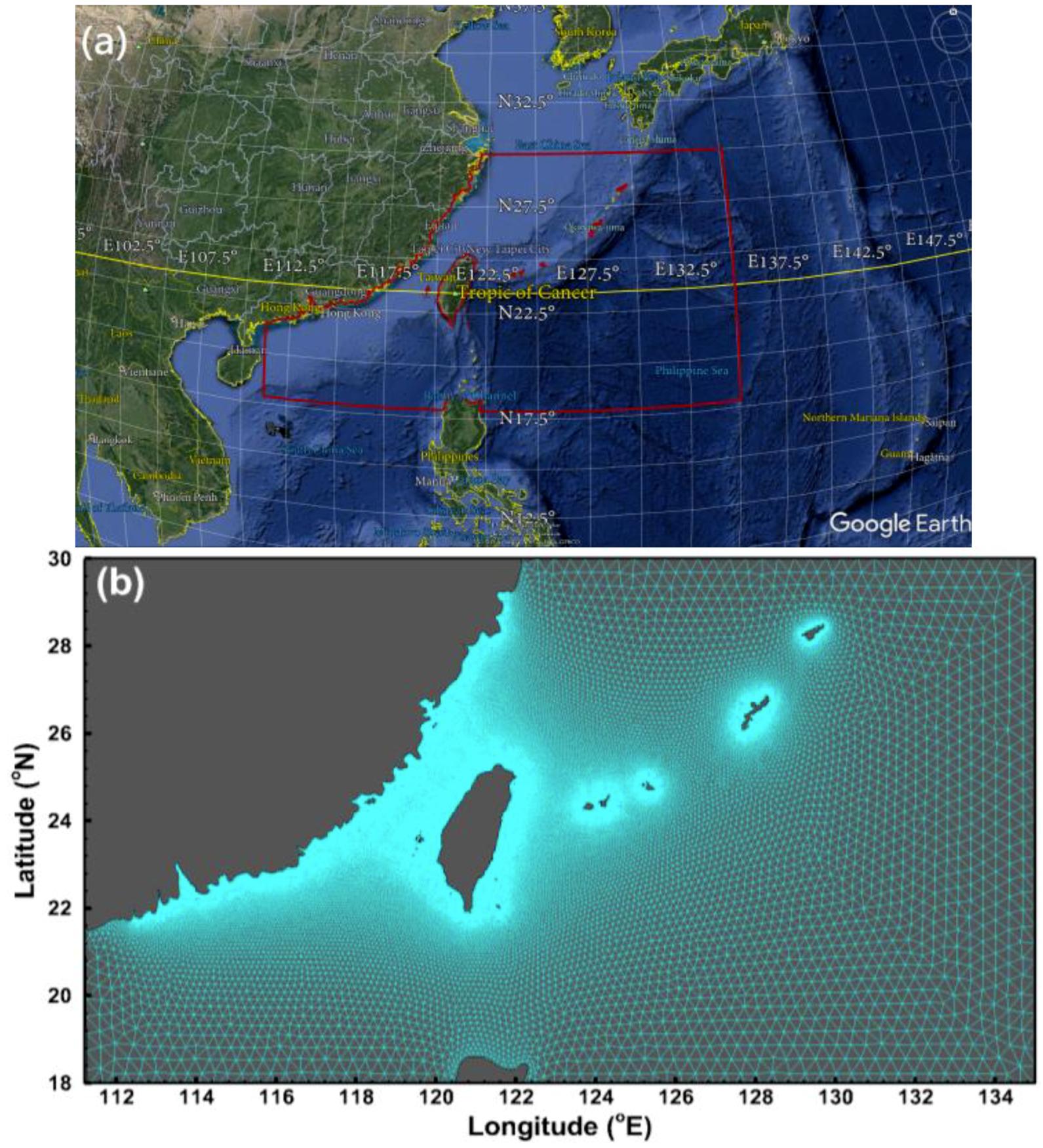
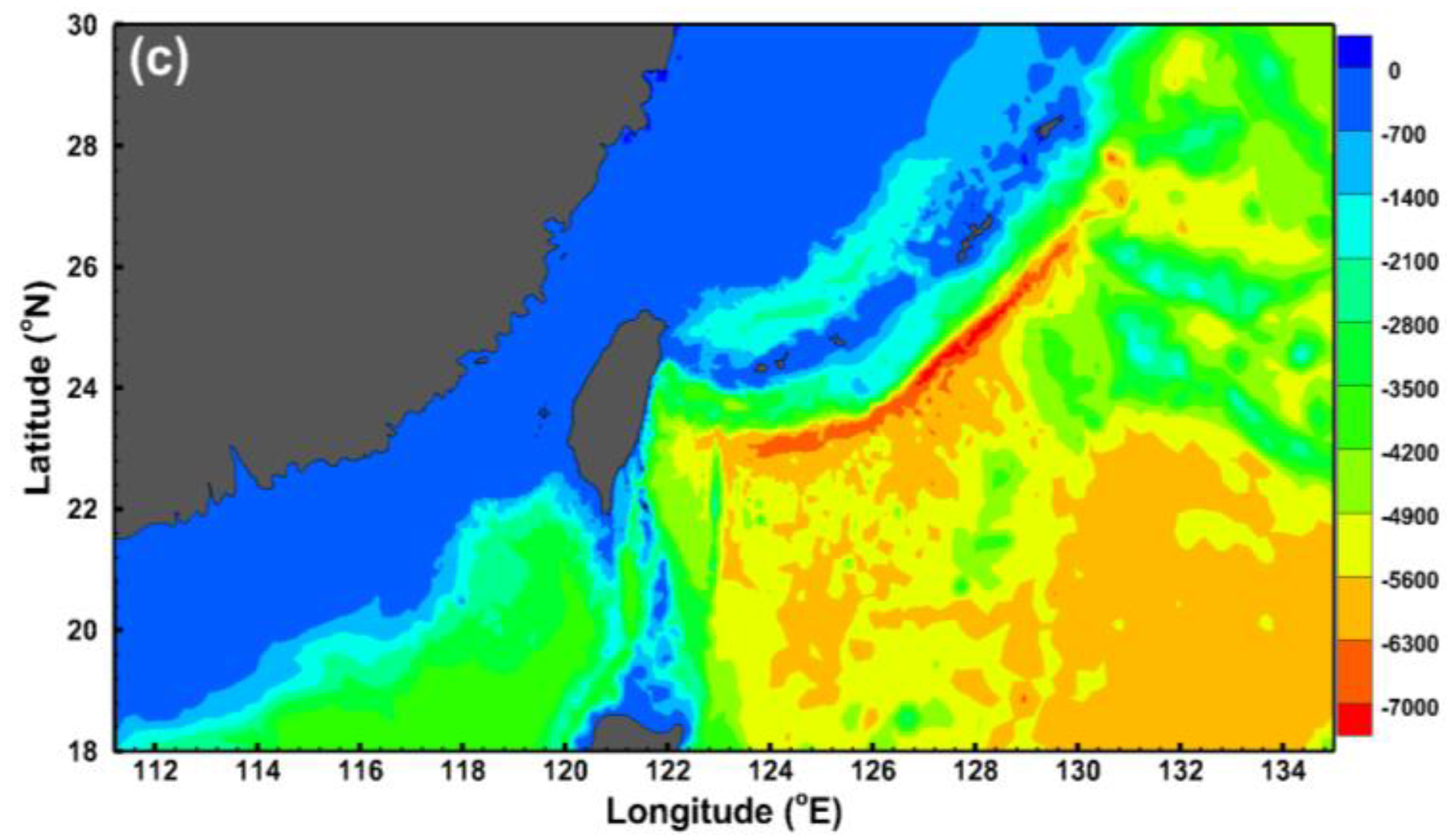
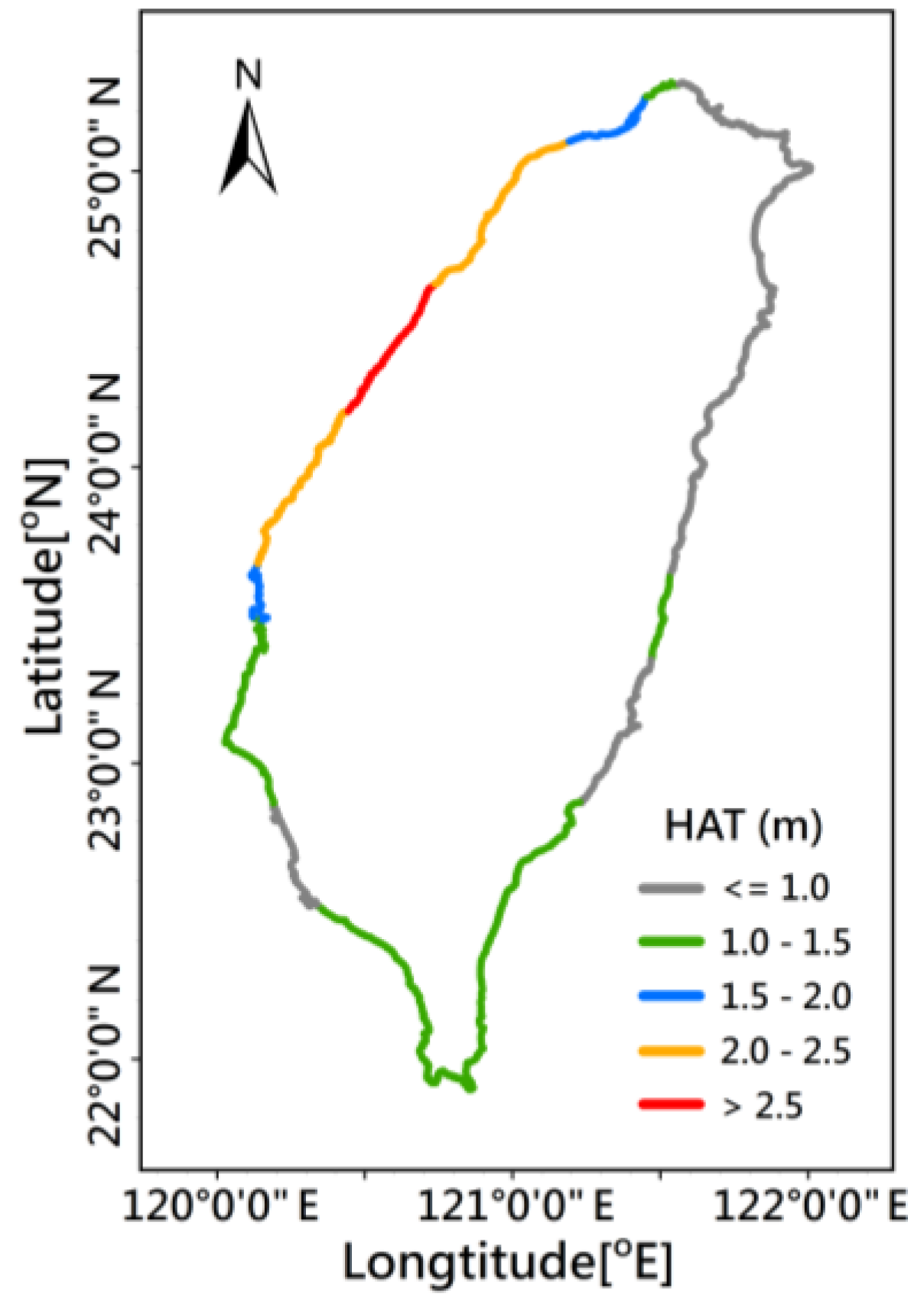

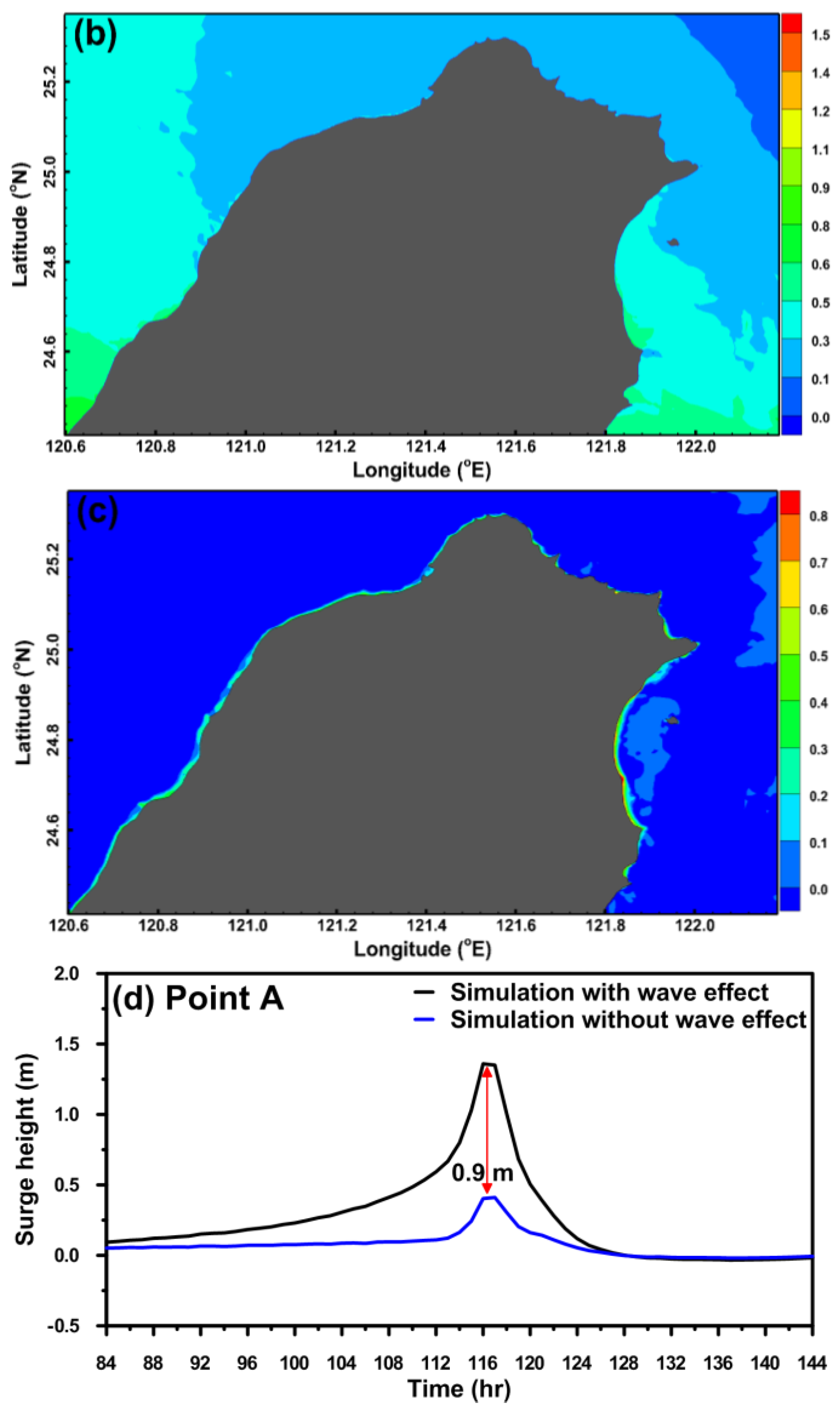
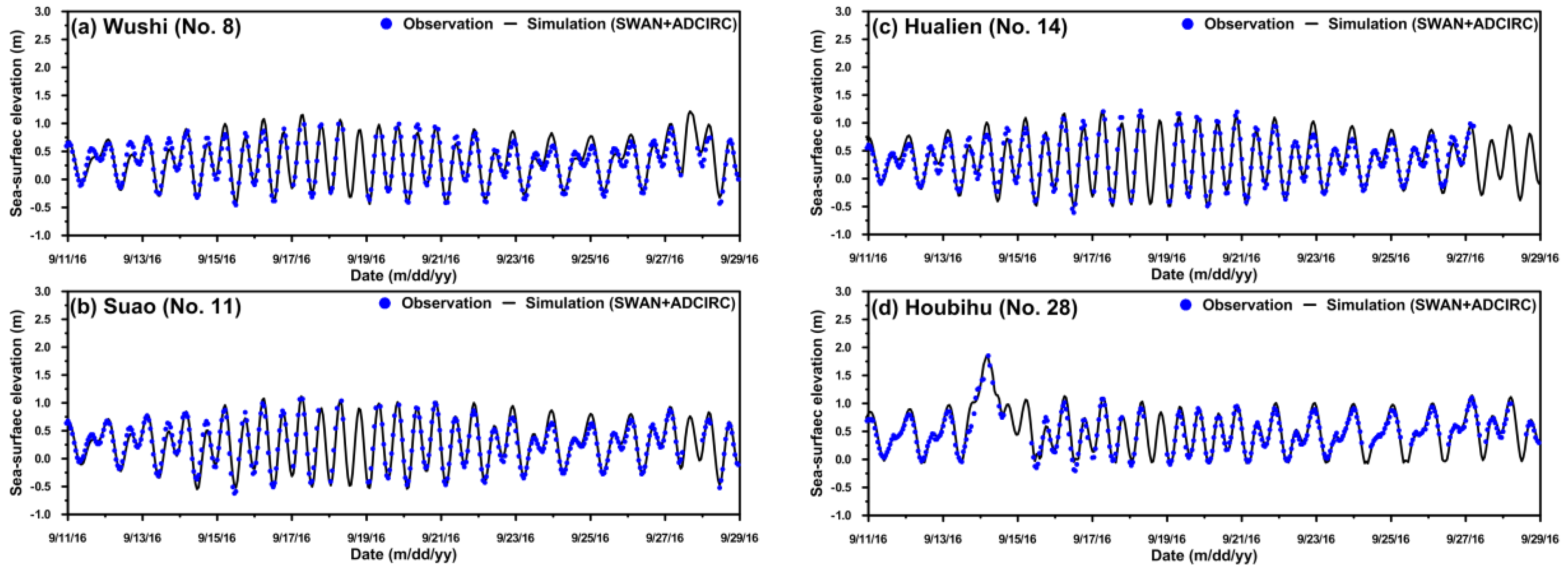
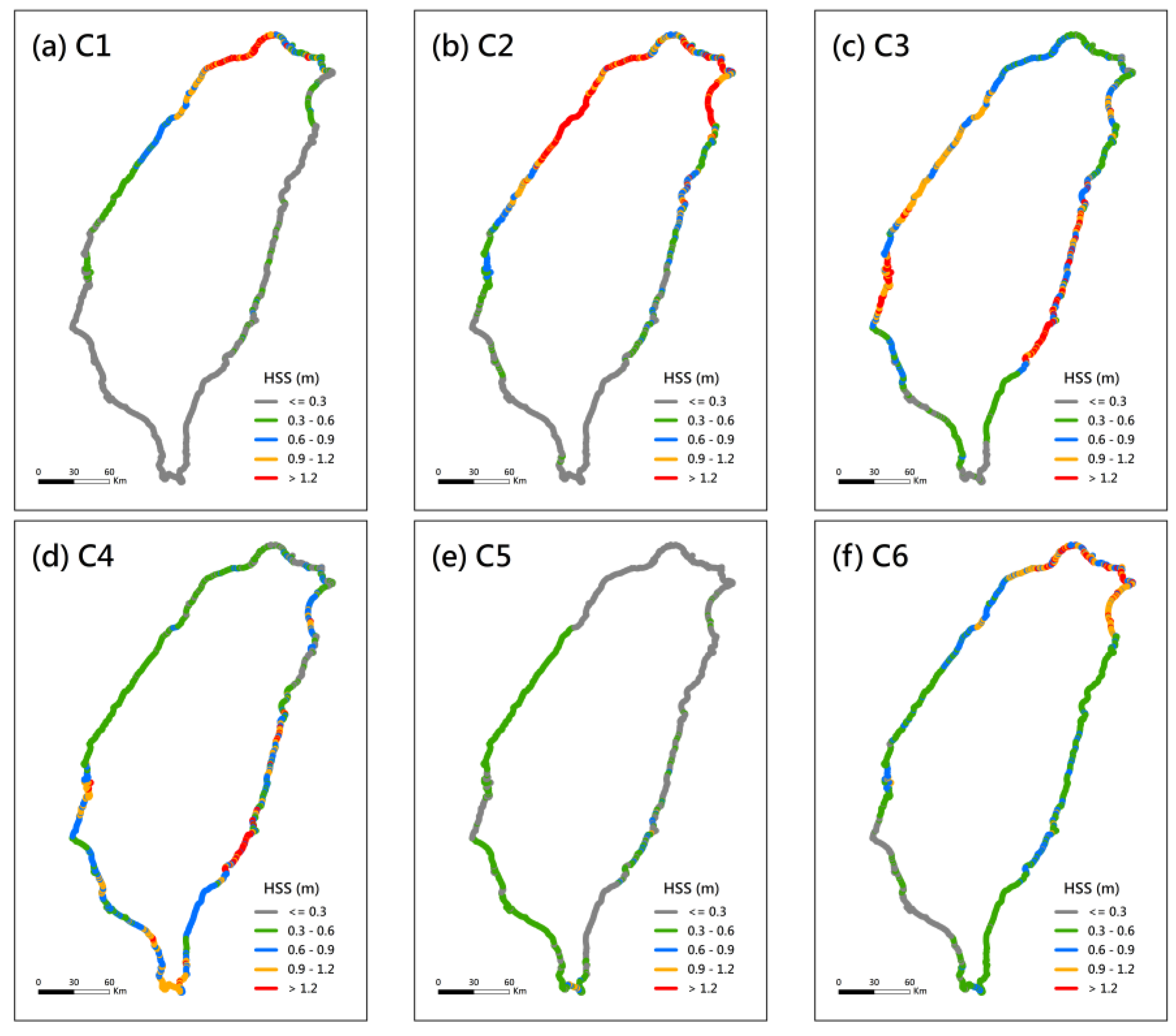
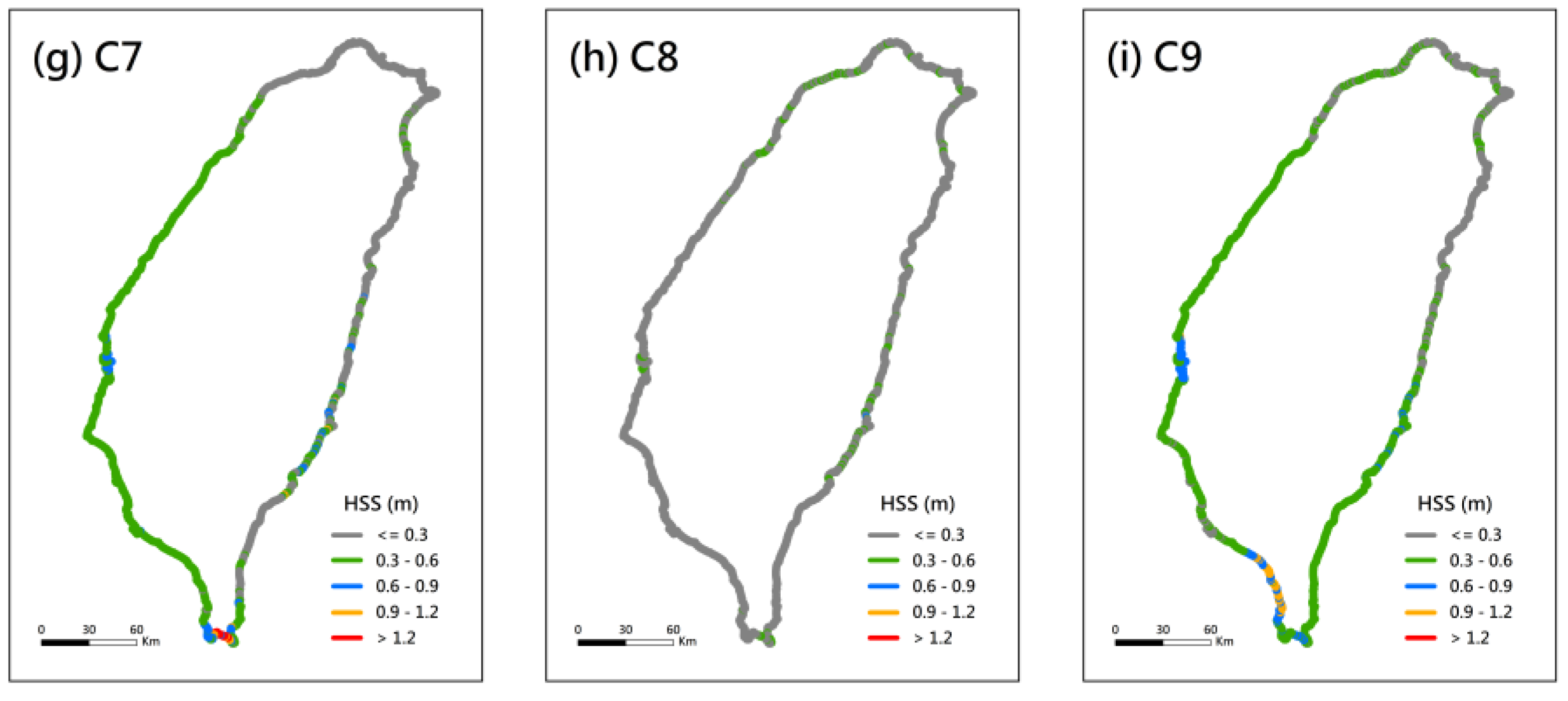
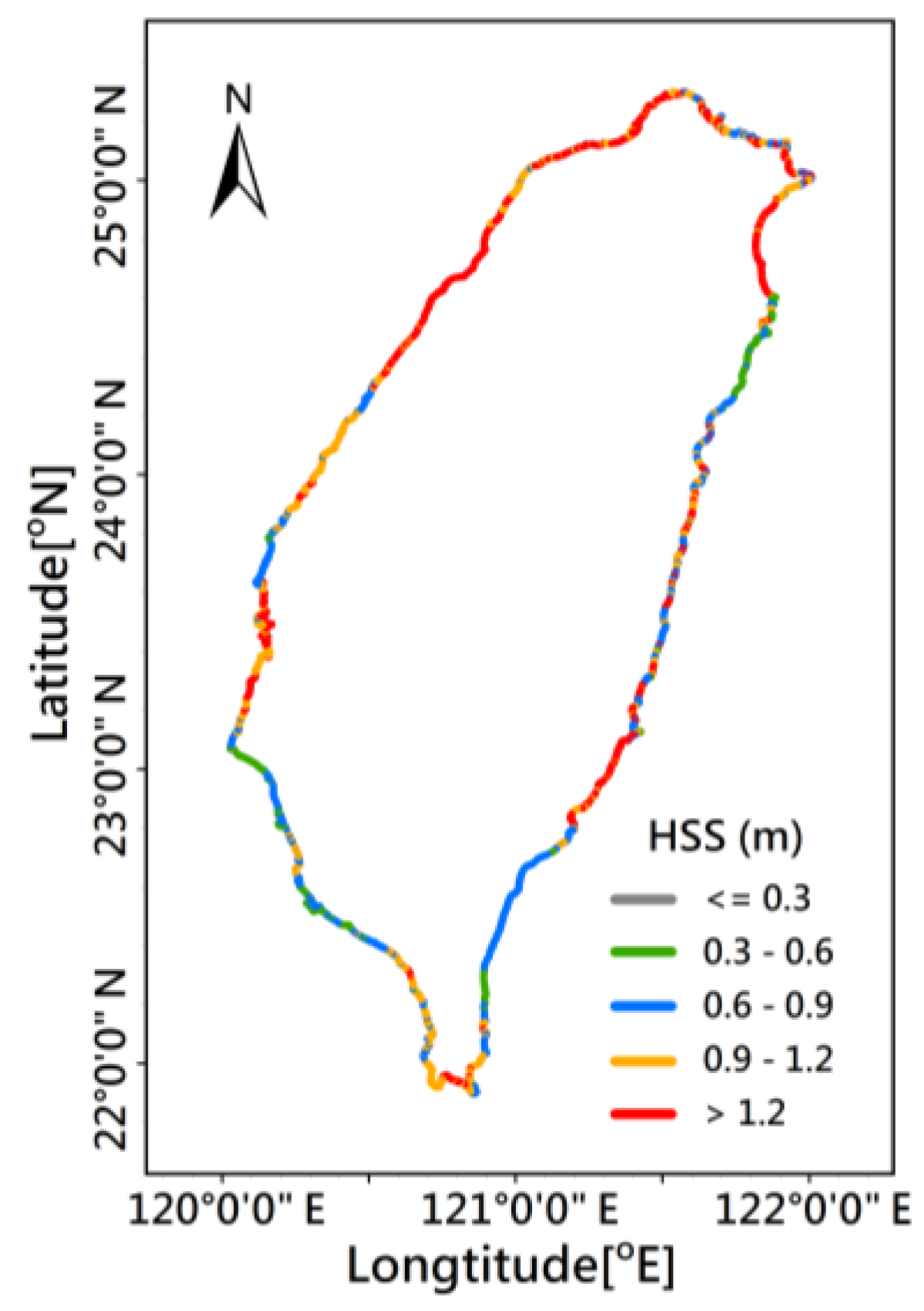
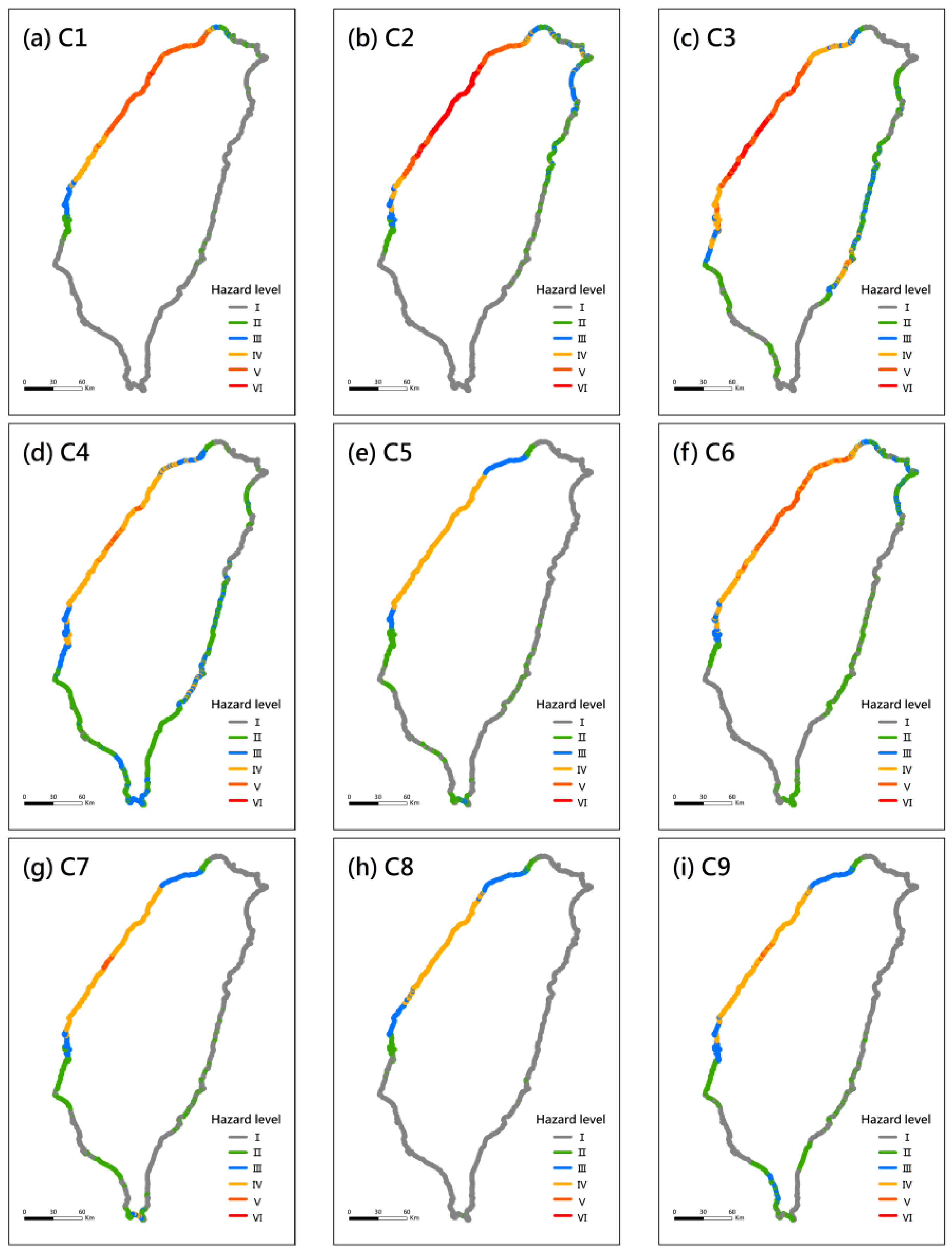
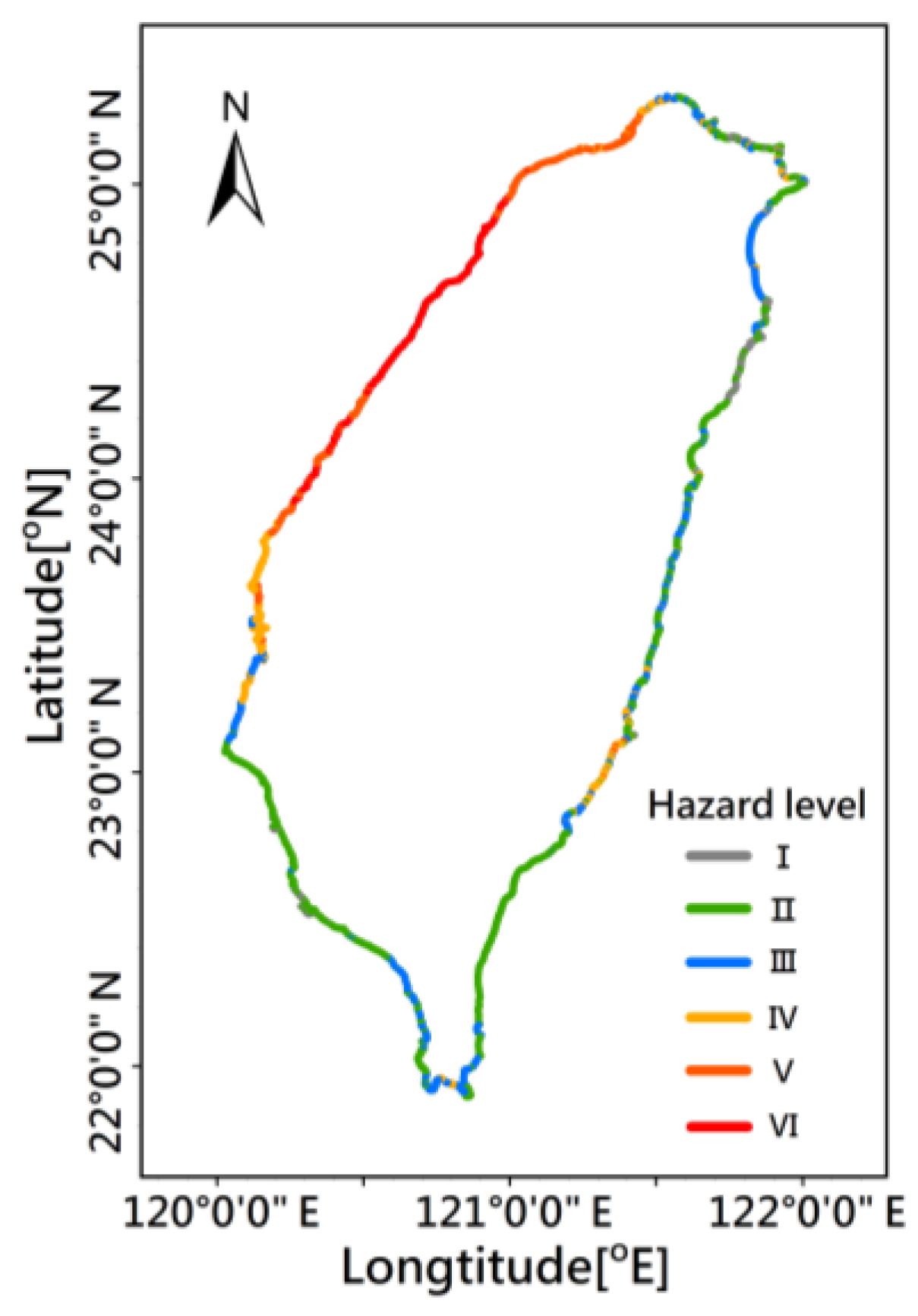
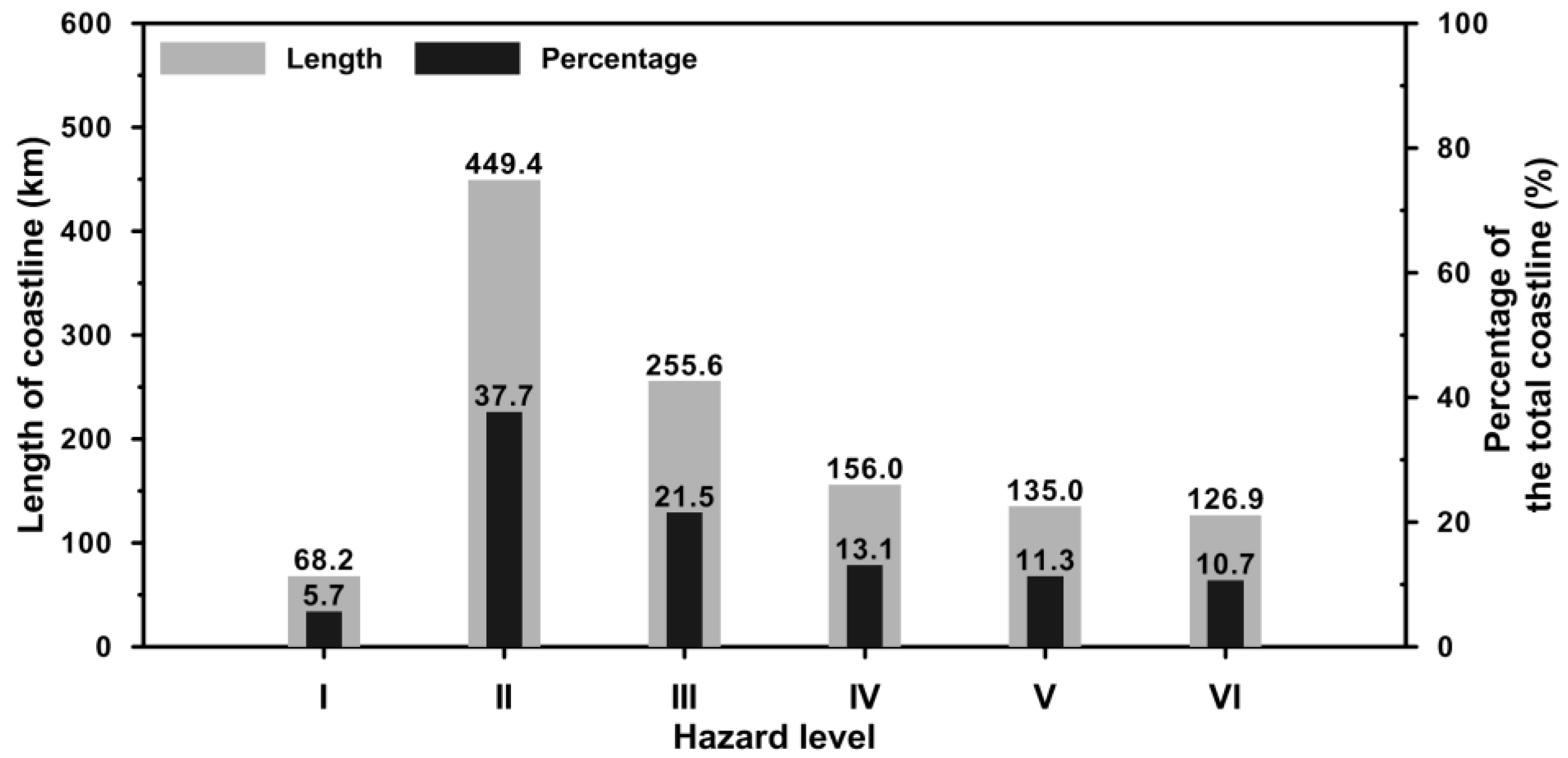
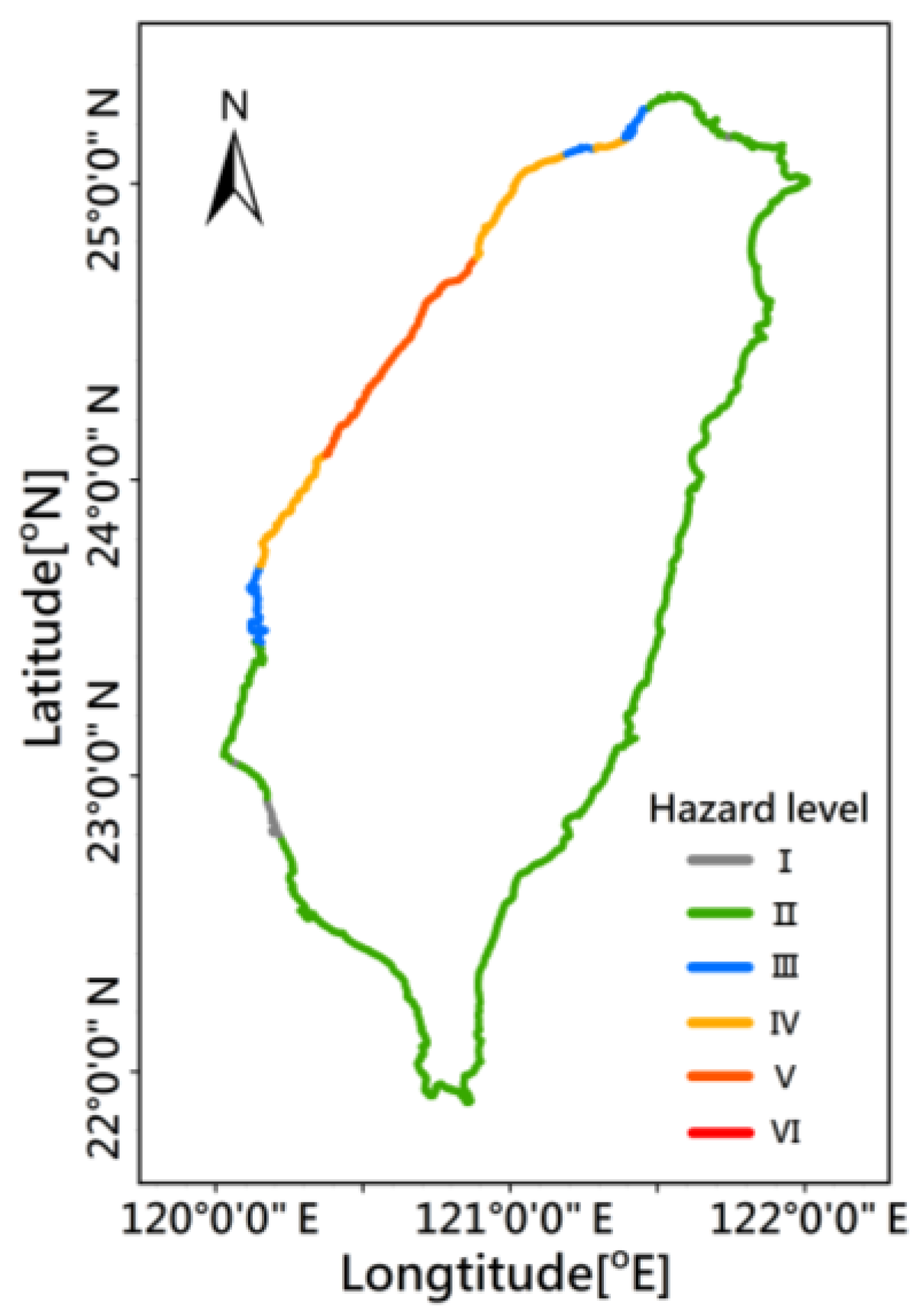
| Number | Name | Longitude (°) | Latitude (°) | HAT (Highest Astronomical Tide, m) |
|---|---|---|---|---|
| 1 | Linshanbi | 121.51 | 25.28 | 1.29 |
| 2 | Tamsui | 121.42 | 25.17 | 1.76 |
| 3 | Tapei Harbor | 121.37 | 25.16 | 2.31 |
| 4 | Keelung | 121.75 | 25.16 | 0.57 |
| 5 | Zhuwei | 121.24 | 25.12 | 1.82 |
| 6 | Longdong | 121.92 | 25.10 | 0.71 |
| 7 | Fulong | 121.95 | 25.02 | 0.66 |
| 8 | Wushi | 121.84 | 24.87 | 0.90 |
| 9 | Hsinchu | 120.92 | 24.85 | 2.51 |
| 10 | Waipu | 120.77 | 24.65 | 2.47 |
| 11 | Suao | 121.87 | 24.59 | 0.98 |
| 12 | Taichung Harbor | 120.53 | 24.29 | 2.63 |
| 13 | Lukang | 120.42 | 24.08 | 2.44 |
| 14 | Hualien | 121.62 | 23.97 | 0.92 |
| 15 | Mailiao | 120.16 | 23.79 | 2.25 |
| 16 | Boziliao | 120.14 | 23.62 | 2.18 |
| 17 | Wengang | 120.12 | 23.52 | 1.21 |
| 18 | Shiti | 121.50 | 23.48 | 1.16 |
| 19 | Dongshi | 120.14 | 23.45 | 1.43 |
| 20 | Jiangjun | 120.02 | 23.21 | 1.22 |
| 21 | Chenggong | 121.38 | 23.10 | 0.93 |
| 22 | Yongan | 120.20 | 22.82 | 0.96 |
| 23 | Taitung | 121.18 | 22.78 | 1.03 |
| 24 | Kaohsiung | 120.29 | 22.61 | 0.85 |
| 25 | Donggang | 120.44 | 22.47 | 1.15 |
| 26 | Dawu | 120.90 | 22.34 | 1.08 |
| 27 | Xunguangzui | 120.71 | 21.99 | 0.99 |
| 28 | Houbihu | 120.75 | 21.95 | 1.18 |
| Hazard level | HST (m) | Description |
|---|---|---|
| I | <= 1.5 | No hazard |
| II | [1.5–2.0) | Very low |
| III | [2.0–2.5) | Low |
| IV | [2.5–3.0) | Medium |
| V | [3.0–3.5) | High |
| VI | >3.5 | Very high |
© 2019 by the authors. Licensee MDPI, Basel, Switzerland. This article is an open access article distributed under the terms and conditions of the Creative Commons Attribution (CC BY) license (http://creativecommons.org/licenses/by/4.0/).
Share and Cite
Yu, Y.-C.; Chen, H.; Shih, H.-J.; Chang, C.-H.; Hsiao, S.-C.; Chen, W.-B.; Chen, Y.-M.; Su, W.-R.; Lin, L.-Y. Assessing the Potential Highest Storm Tide Hazard in Taiwan Based on 40-Year Historical Typhoon Surge Hindcasting. Atmosphere 2019, 10, 346. https://doi.org/10.3390/atmos10060346
Yu Y-C, Chen H, Shih H-J, Chang C-H, Hsiao S-C, Chen W-B, Chen Y-M, Su W-R, Lin L-Y. Assessing the Potential Highest Storm Tide Hazard in Taiwan Based on 40-Year Historical Typhoon Surge Hindcasting. Atmosphere. 2019; 10(6):346. https://doi.org/10.3390/atmos10060346
Chicago/Turabian StyleYu, Yi-Chiang, Hongey Chen, Hung-Ju Shih, Chih-Hsin Chang, Shih-Chun Hsiao, Wei-Bo Chen, Yung-Ming Chen, Wen-Ray Su, and Lee-Yaw Lin. 2019. "Assessing the Potential Highest Storm Tide Hazard in Taiwan Based on 40-Year Historical Typhoon Surge Hindcasting" Atmosphere 10, no. 6: 346. https://doi.org/10.3390/atmos10060346
APA StyleYu, Y.-C., Chen, H., Shih, H.-J., Chang, C.-H., Hsiao, S.-C., Chen, W.-B., Chen, Y.-M., Su, W.-R., & Lin, L.-Y. (2019). Assessing the Potential Highest Storm Tide Hazard in Taiwan Based on 40-Year Historical Typhoon Surge Hindcasting. Atmosphere, 10(6), 346. https://doi.org/10.3390/atmos10060346








